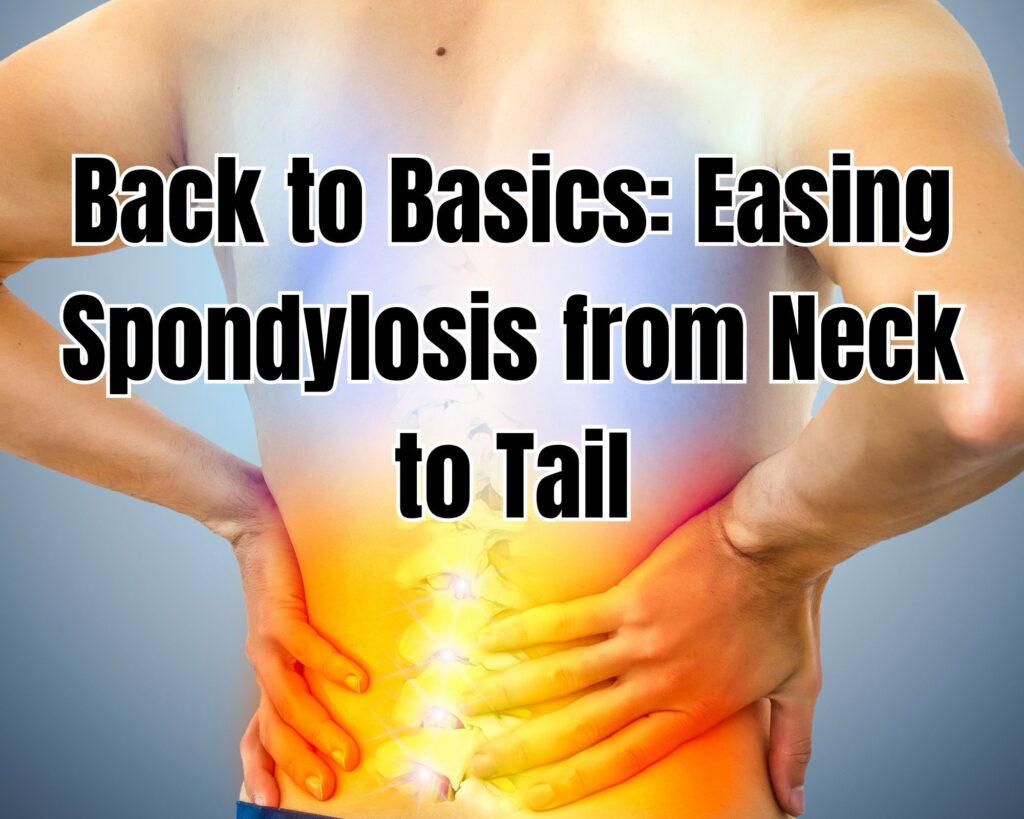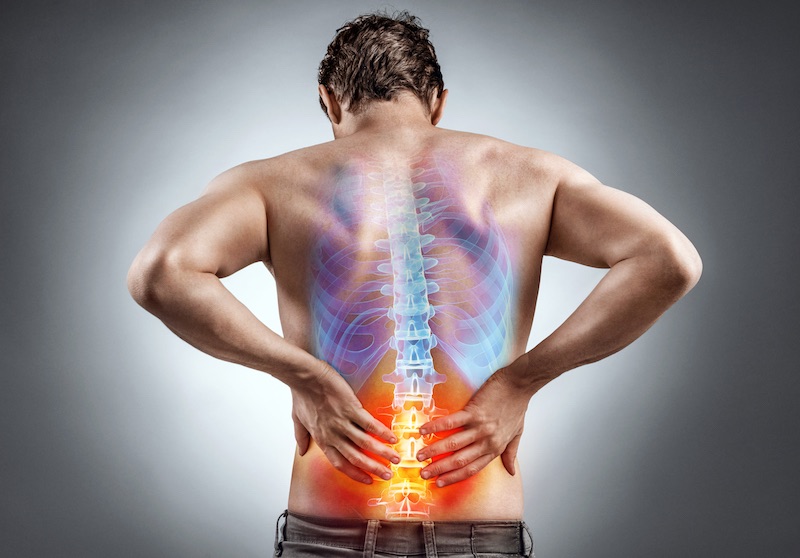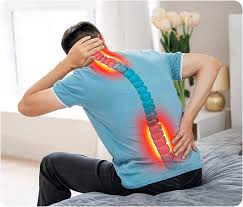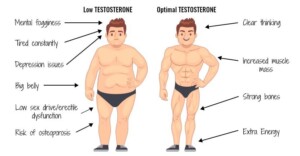
Unraveling the Connection Between Spondylosis and Upper Body Pain
Have you ever wondered if the aches in your lower back could be puppeteering the pain in your neck and shoulders? It sounds a bit like a medical mystery, but for many suffering from lumbar spondylosis, it’s an everyday reality. Spondylosis, a fancy term for the wear and tear of spinal discs, isn’t just confined to the area where it starts. Like a bad rumor, the effects can spread, impacting parts of the body far from the original source. In this article, we’ll dive deep into how lower back issues from spondylosis could potentially cause neck and shoulder pain, and importantly, what you can do about it. So, strap in and get ready to connect the dots on your spinal health.

The Anatomy of Spondylosis and Its Ripple Effects
Spondylosis primarily affects the spine’s vertebrae and discs, particularly as we age. In the lumbar region—your lower back—this degeneration can lead to chronic back pain and stiffness. But the spine is a complex interconnected highway that doesn’t operate in isolation. Each section supports the others, and trouble in one area can lead to compensatory issues elsewhere.
How Compensatory Mechanics Work
When lower back pain kicks in, your body naturally tries to adapt and compensate. This might mean you alter your posture without even realizing it, leaning slightly forward or adjusting how you sit and stand to avoid pain. These small shifts can place unusual stress on the neck and shoulders, which now have to work harder to keep your head balanced and maintain alignment.
The Chain Reaction
Consider this: your spine is like a stack of cups. If the bottom cup starts to wobble, the instability travels up, affecting the entire stack. Similarly, instability or changes in the lumbar spine influence the thoracic (middle) and cervical (neck) regions. Over time, this can lead to muscle strain, pinched nerves, and even changes in the joints and muscles of your neck and shoulders. The result? Pain, and sometimes lots of it, where you least expect it.
In the next section, we’ll explore the specific symptoms that suggest your neck and shoulder pains could be echoes of lower back issues, helping you better understand and trace the origins of your discomfort. Stay tuned as we continue to unravel the mysteries of spondylosis and its broader impacts on your body.

Recognizing the Symptoms Linking Lower Back to Neck and Shoulder Pain
Understanding the symptoms that link lower back issues to neck and shoulder pain is key to managing and eventually alleviating the discomfort. While it might seem unrelated at first, the interconnected nature of the musculoskeletal system often means that pain in one area can lead to problems in another. Here’s how you can identify whether your neck and shoulder pain might be stemming from your lower back condition.
Common Symptoms to Watch For
Increased Tension in Neck Muscles: As your body compensates for lower back pain, you might unconsciously tense up your neck muscles to maintain stability and posture. This constant tension can lead to chronic neck pain and stiffness, often mistaken for other conditions like tension headaches or migraines.
Shoulder Discomfort and Reduced Mobility: Shoulder pain often accompanies neck pain, especially if your posture changes involve hunching or rounding your shoulders forward. You may also notice a decrease in shoulder mobility, making it difficult to perform overhead activities or even simple tasks like putting on a coat.
Radiating Pain: Sometimes, the nerves affected by spinal changes in your lower back can cause symptoms to radiate upwards. This might result in a tingling sensation or sharp pains shooting through the neck and shoulders, a clear indicator that your spinal health needs attention.
Headaches: Yes, your lower back can even influence the occurrence of headaches. Misalignments and tension in the spine and neck can trigger cervicogenic headaches, which are headaches that originate from cervical spine issues.
Connection to Broader Health Issues
It’s also important to consider how these symptoms might relate to other health conditions. For example, TMJ (temporomandibular joint disorder) can also be exacerbated by poor posture and spinal issues. Understanding the signs and symptoms of TMJ can give you a more comprehensive view of your musculoskeletal health. For a deeper dive into TMJ and its symptoms, you can read more here.
By recognizing these symptoms early, you can take proactive steps to address the root causes of your pain. Adjusting your posture, seeking appropriate medical or therapeutic interventions, and maintaining an awareness of how your body compensates for pain can make a significant difference in your quality of life.
In the next section, we’ll explore proactive measures and treatments that can help manage and alleviate the pain caused by this complex interplay between your lower back, neck, and shoulders. Stay tuned for practical advice on turning your pain management strategy into an effective routine.

Proactive Measures to Manage and Alleviate Pain
Once you’ve identified the interconnected symptoms of spondylosis affecting your lower back, neck, and shoulders, it’s time to take proactive steps to manage and hopefully reduce your discomfort. Effective pain management involves a combination of lifestyle adjustments, therapeutic interventions, and possibly medical treatments. Here’s what you can do to take control and improve your quality of life.
Lifestyle Adjustments for Better Posture and Alignment
Ergonomic Workspace: Ensure that your workspace promotes good posture. Adjust your chair, desk, and computer monitor so that they support a natural sitting position. Your feet should rest flat on the floor, and your computer screen should be at eye level to avoid tilting your head down or up.
Mindful Posture: Be conscious of your posture throughout the day. Avoid slouching or leaning to one side, especially when using mobile devices. Try to keep your ears in line with your shoulders and your shoulders in line with your hips.
Therapeutic Interventions
Physical Therapy: A physical therapist can teach you exercises specifically designed to strengthen the muscles that support your spine and improve flexibility in the affected areas. Targeted exercises can alleviate pressure on the nerves and reduce pain.
Chiropractic Care: Chiropractors can provide adjustments that help realign your spine and relieve pressure on nerves that may be contributing to your pain.
Massage Therapy: Regular massage can help reduce muscle tension in the neck, shoulders, and back. It’s particularly effective for managing stress-related tension and improving circulation to the affected areas.
Supportive Devices
For those days when you need extra support to manage your pain, consider using helpful devices like:
- Back Brace Posture Corrector for Women and Men: This device helps to realign your posture by gently pulling your shoulders back, which can alleviate stress on the lower back, neck, and shoulders.
- Yoga and Stretching: Integrating yoga or a regular stretching routine can enhance flexibility and reduce stiffness. Focus on gentle stretches that elongate the spine and relieve compression.
Medicinal Approaches
Over-the-counter pain relievers: For acute pain episodes, over-the-counter medications like ibuprofen can be effective. However, it’s important to use them judiciously. For a deeper understanding of the benefits and risks associated with chronic use of pain relievers like ibuprofen, consider reading “Is Daily Ibuprofen Your Pain Relief Hero or Hidden Villain?”.
Implementing these proactive measures can significantly impact your ability to manage spondylosis and its related symptoms. By taking control of your environment, engaging in therapeutic practices, and utilizing supportive devices, you can help prevent further deterioration of your condition and maintain a more pain-free lifestyle.
In the next section, we will explore additional therapeutic solutions that specifically target and relieve pain, providing you with a comprehensive toolkit for managing your spondylosis effectively. Stay tuned for more tips and tricks to keep your spine in great shape!

Therapeutic Solutions for Comprehensive Pain Relief
When dealing with the complex symptoms of spondylosis that affect multiple areas of the body, integrating advanced therapeutic solutions can significantly enhance your pain management strategy. These treatments are designed to target the root causes of pain, offer relief, and improve your overall mobility and quality of life.
Advanced Pain Management Techniques
TENS Therapy: Transcutaneous Electrical Nerve Stimulation (TENS) has been shown to be effective in managing chronic pain. It uses low-voltage electrical currents to relieve pain by interrupting pain signals before they reach the brain. For those experiencing neck, shoulder, and back pain, a device like the TENS Unit Muscle Stimulator can be particularly helpful in providing on-demand pain relief.
Acupuncture: This traditional Chinese medicine technique involves inserting thin needles into specific points on the body. It’s thought to trigger the release of pain-relieving chemicals in the body and can be a valuable part of a holistic approach to managing spondylosis symptoms.
Cognitive Behavioral Therapy (CBT): Chronic pain often affects mental health, leading to conditions like anxiety and depression. CBT can help by changing the pain-related thoughts, behaviors, and emotions, and can also improve pain coping strategies.
Daily Support and Mobility Aids
Ergonomic Supports: Using ergonomic aids can significantly reduce strain and support proper posture throughout the day. The Cushion Lab Patented Pressure Relief Seat Cushion is an excellent example of a product designed to provide optimal comfort and support for those spending long hours seated, particularly beneficial for managing lower back pain.
Heat Therapy: Applying heat can help reduce muscle stiffness and pain in the neck, shoulders, and lower back. Heat therapy can be applied using heating pads, warm gel packs, or even warm baths, which help to increase blood flow and soothe discomfort.
Exercise and Movement
Structured Exercise Programs: Engaging in a structured exercise program designed by a physical therapist can help strengthen the muscles around the spine, improving posture and reducing the burden on the affected areas.
Yoga and Pilates: These practices focus on strengthening and stretching, which are essential for spinal health. They also promote mindfulness, which can help manage the psychological aspects of chronic pain.
Integrating these therapeutic solutions into your daily routine can not only provide immediate relief but also contribute to long-term health benefits. By addressing both the physical and psychological aspects of pain, you can achieve a more comprehensive and effective management of your spondylosis symptoms.
In the final section, we’ll wrap up with some concluding thoughts on living with spondylosis and maintaining a positive outlook despite chronic pain. We’ll discuss further strategies to cope with the condition and maintain a high quality of life.

Empowering Yourself to Manage Spondylosis Effectively
Living with spondylosis, particularly when it affects multiple areas such as the lower back, neck, and shoulders, can be challenging. However, with the right strategies and a proactive approach to managing your condition, you can maintain a good quality of life and minimize discomfort. Here are some final thoughts and tips to help you stay empowered in your journey with spondylosis.
Stay Informed and Proactive
Knowledge is power when it comes to managing chronic conditions like spondylosis. Stay informed about the latest treatments, exercises, and lifestyle recommendations that can help you manage your symptoms. Regular consultations with healthcare professionals, whether it’s a physical therapist, chiropractor, or pain specialist, can provide you with personalized advice and adjustments to your treatment plan.
Maintain a Balanced Lifestyle
Balance is key in managing chronic pain effectively. This includes a balanced diet, regular exercise, and sufficient rest, all of which contribute to overall spinal health. Additionally, consider mental health practices such as mindfulness or meditation, which can help you manage the psychological impacts of living with chronic pain.
Community and Support
Don’t underestimate the power of community and support. Connecting with others who are also managing chronic pain can provide not only practical advice but also emotional support. Support groups, whether online or in person, can be invaluable resources for sharing experiences and coping strategies.
Set Realistic Goals
Set realistic, achievable goals for yourself in terms of pain management and mobility. Celebrate small victories, whether it’s completing a physical therapy session, enjoying a social outing, or simply having a good day with manageable pain levels. Recognizing and celebrating progress can be a great motivator.
Adapt and Modify
As your condition changes, so might your needs. Be open to modifying your pain management strategies as necessary. This might include trying new therapies, adjusting medications, or changing your exercise routine. Flexibility in your approach can help you find what works best for you at different stages of your life.
By adopting these strategies, you can better manage the symptoms of spondylosis and maintain an active, fulfilling life. Remember, you are not your diagnosis. With the right approach, you can manage your condition effectively and continue to enjoy many of life’s pleasures. Let this journey of management and discovery remind you of your resilience and ability to adapt to life’s challenges.
Living with this condition of spondylosis is very frustrating and debilitating. We hope this article sheds some light on this topic to help you, as I live with this myself and it’s terrible.
As an Amazon Associate we earn from qualifying purchases through some links in our articles.




